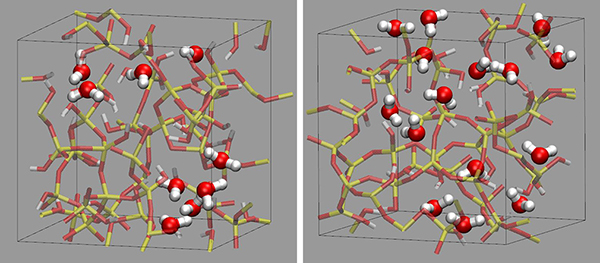ENVIRONMENT AND ENERGY
Ab Initio Geochemistry of the Deep Earth
Principal Investigator:
Sandro Jahn
Affiliation:
Deutsches GeoForschungsZentrum/GFZ, Potsdam
Local Project ID:
hpo15
HPC Platform used:
JUQUEEN of JSC
Date published:
Minerals, melts and fluids are the building blocks of our planet Earth. Their formation and alteration are driven by thermodynamics and depend on pressure, temperature and the local availability of chemical elements. Geological processes are especially efficient at high temperatures as prevalent in the Earth's interior and in the presence of melts or (aqueous) fluids. However, direct observations, e.g. by deep drilling, are limited to about 12 km depth. Experimental studies at the extreme conditions of the deeper Earth are challenging and not always easy to interpret. Therefore, a good understanding of what happens beneath our feet can only be obtained by combined efforts from various disciplines of the Earth sciences.
The group of Dr. Sandro Jahn at GFZ German Research Centre for Geosciences uses molecular modeling approaches based on quantum mechanics to develop structure models for crystals as well as disordered materials at the conditions of the Earth's lower crust and mantle. Such ab initio simulations also provide a unique access to physical properties and thermodynamic potentials of the respective materials, which eventually allows to make first-principles predictions of how heat and matter are transported inside the Earth, or how elements and their isotopes distribute e.g. during fluid-rock interactions. Simulations of this kind are computationally very demanding and have only become feasible with the availability of supercomputers. Still, current model systems have simplified compositions and are limited to a few hundred atoms. Besides the need for bigger computers, a major challenge is the further development of accurate and efficient computational methods, which may allow us in the near future to gain unprecedented insight, e.g., into ore-forming processes or into the chemical differentiation of the early and the present Earth.
This work has been funded by the Deutsche Forschungsgemeinschaft within the Emmy-Noether program. Simulations were performed on the supercomputers JUQUEEN and JUROPA at Jülich Supercomputing Centre thanks to allocated computing time within NIC project HPO15.

Change of the molecular structure of an SiO2-H2O fluid during cooling from 3000 K (left) to 2400 K. The increased number of H2O molecules at lower temperature may be interpreted as a precursor of unmixing of a silicate melt and a fluid phase, which is a typical process associated e.g. to explosive volcanism. Copyright: © Deutsches GeoForschungsZentrum GFZ, Sektion 3.3
Dr. Sandro Jahn
Deutsches GeoForschungsZentrum GFZ, Sektion 3.3
Telegrafenberg, D-14473 Potsdam/Germany
e-mail: jahn@gfz-potsdam.de